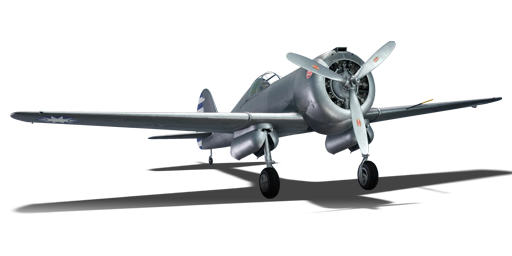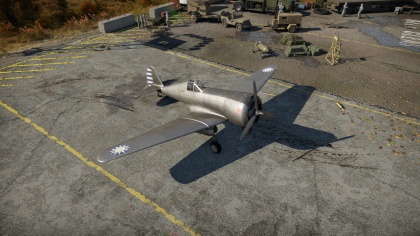CW-21
Contents
Description
The CW-21 is a rank I Chinese twin-engine fighter
with a battle rating of 2.0 (AB/SB) and 2.7 (RB). It was introduced in Update 1.91 "Night Vision".
General info
Flight performance
Describe how the aircraft behaves in the air. Speed, manoeuvrability, acceleration and allowable loads - these are the most important characteristics of the vehicle.
| Characteristics | |||||||
|---|---|---|---|---|---|---|---|
| Stock | |||||||
| Max Speed (km/h at 3,700 m) |
Max altitude (meters) |
Turn time (seconds) |
Rate of climb (meters/second) |
Take-off run (meters) | |||
| AB | RB | AB | RB | AB | RB | ||
| 480 | 465 | 10800 | 14.2 | 15.0 | 13.4 | 13.4 | 343 |
| Upgraded | |||||||
| Max Speed (km/h at 3,700 m) |
Max altitude (meters) |
Turn time (seconds) |
Rate of climb (meters/second) |
Take-off run (meters) | |||
| AB | RB | AB | RB | AB | RB | ||
| ??? | 505 | 10800 | ??.? | 14.0 | ??.? | 18.2 | 343 |
Details
| Features | ||||
|---|---|---|---|---|
| Combat flaps | Take-off flaps | Landing flaps | Air brakes | Arrestor gear |
| ✓ | ✓ | ✓ | X | X |
| Limits | ||||
|---|---|---|---|---|
| Wing-break speed (km/h) |
Gear limit (km/h) |
Combat flaps (km/h) |
Max Static G | |
| + | - | |||
| 380 | ~10 | ~5 | ||
| Optimal velocities | |||
|---|---|---|---|
| Ailerons (km/h) |
Rudder (km/h) |
Elevators (km/h) |
Radiator (km/h) |
| < 280 | < 260 | < 450 | > 250 |
| Compressor (RB/SB) | ||
|---|---|---|
| Setting 1 | ||
| Optimal altitude | 100% Engine power | WEP Engine power |
| 1,829 m | 850 hp | 1,000 hp |
| Setting 2 | ||
| Optimal altitude | 100% Engine power | WEP Engine power |
| 4,633 m | 750 hp | 882 hp |
Survivability and armour
Examine the survivability of the aircraft. Note how vulnerable the structure is and how secure the pilot is, whether the fuel tanks are armoured, etc. Describe the armour, if there is any, and also mention the vulnerability of other critical aircraft systems.
Armaments
Offensive armament
The CW-21 is armed with:
- 2 x 12.7 mm Browning M2 machine guns, nose-mounted (200 rpg = 400 total)
- 2 x 7.62 mm Browning machine guns, nose-mounted (500 rpg = 1,000 total)
Usage in battles
Describe the tactics of playing in the aircraft, the features of using aircraft in a team and advice on tactics. Refrain from creating a "guide" - do not impose a single point of view, but instead, give the reader food for thought. Examine the most dangerous enemies and give recommendations on fighting them. If necessary, note the specifics of the game in different modes (AB, RB, SB).
Manual Engine Control
| MEC elements | ||||||
|---|---|---|---|---|---|---|
| Mixer | Pitch | Radiator | Supercharger | Turbocharger | ||
| Oil | Water | Type | ||||
| Controllable | Controllable Not auto controlled |
Not controllable Not auto controlled |
Not controllable Not auto controlled |
Separate | Controllable 2 gears |
Not controllable |
Modules
| Tier | Flight performance | Survivability | Weaponry | ||
|---|---|---|---|---|---|
| I | Fuselage repair | Radiator | Offensive 7 mm | ||
| II | Compressor | Airframe | Offensive 12 mm | ||
| III | Wings repair | Engine | New 7 mm MGs | ||
| IV | Engine injection | Cover | New 12 mm MGs | ||
Pros and cons
Summarise and briefly evaluate the vehicle in terms of its characteristics and combat effectiveness. Mark its pros and cons in the bulleted list. Try not to use more than 6 points for each of the characteristics. Avoid using categorical definitions such as "bad", "good" and the like - use substitutions with softer forms such as "inadequate" and "effective".
Pros:
- Respectable firepower for the rank
- Turn rate is on par with the early Spitfires and even A6Ms
Cons:
- Not very fast
- Very fragile
- Climb rate is not the best for the rank
History
In 1938, George A. Page, head of the Saint Louis Airplane Division of Curtiss-Wright, decided to develop a fighter aircraft based on Carl W. Scott's two seater Model 19. Page's concept was a lightweight fighter interceptor with as high a rate of climb as possible in order to allow bomber formations to be attacked with minimal warning. If faced with fighter opposition, it was intended not to dogfight, but to use its superior climb rate to escape. While this was a direct contradiction to the United States Army Air Corps′ requirements for fighters (which stressed low-level performance), this did not concern Page, since the new fighter was intended for export.
The prototype first flew on 22 September 1938, carrying the civil experimental registration NX19431. Although the CW-21 was not commissioned by the U.S. military, it was test flown at Wright Field in Dayton, Ohio. The Army Air Corps immediately rejected the aircraft, with one officer commenting that it took a genius to land it.
The prototype CW-21 was delivered to China for evaluation by the Chinese Air Force. The Chinese were impressed by the CW-21's performance, and negotiation started on a Chinese purchase. While these negotiations were ongoing, the CW-21 prototype was flown in combat against Japanese bombers attacking Chungking, with Curtiss test pilot Bob Fausel claiming a Fiat BR.20 bomber shot down on 4 April 1939. In May 1939, a contract was signed, with China receiving the prototype and three complete examples built by Curtiss, as well as kits for 27 more aircraft. Assembly would be undertaken by the Central Aircraft Manufacturing Company (CAMCO) at Loiwing, near the China-Burma border. These were to be armed with two .50 in (12.7 mm) and two .30 in (7.62 mm) machine guns.
The three Curtiss-built aircraft were shipped to China in May 1940 and were eventually handed over to the 1st American Volunteer Group (Flying Tigers), who intended to use them to tackle high-flying Japanese reconnaissance aircraft. These crashed and were destroyed, due to poor visibility, on a flight from Rangoon to Kunming on 23 December 1941. Of the 27 to be assembled by CAMCO, none were completed before CAMCO was forced by advancing Japanese forces to evacuate its Loiwing factory to India in 1942.
-Wikipedia[1]
Media
Excellent additions to the article would be video guides, screenshots from the game, and photos.
See also
Links to the articles on the War Thunder Wiki that you think will be useful for the reader, for example:
- reference to the series of the aircraft;
- links to approximate analogues of other nations and research trees.
External links
Paste links to sources and external resources, such as:
- topic on the official game forum;
- encyclopedia page on the aircraft;
- other literature.
| China fighters | |
|---|---|
| British | ␗Gladiator Mk I |
| French | D.510C |
| Japanese | ␗A6M2 · ␗Ki-27 otsu · ␗Ki-43-III ko · ␗Ki-44-II hei · ␗Ki-61-I otsu · ␗Ki-84 ko |
| American | CW-21 · Hawk III · P-66 · ␗P-40E-1 · H-81A-2 · ␗P-43A-1 |
| ␗P-47D-23-RA · ␗P-47D-30 · ␗F-47N-25-RE · ␗P-51C-11-NT · ␗P-51D-20 · ␗P-51K | |
| Soviet | ␗I-15bis · ␗I-153 M-62 · ␗I-16 Chung 28 · ␗I-16 type 5 · ␗I-16 type 10 · ␗I-16 type 17 · ␗La-11 · ␗La-9 |





